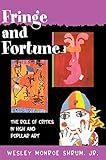Fringe and Fortune : The Role of Critics in High and Popular Art / Wesley Monroe Shrum.
Material type: TextPublisher: Princeton, NJ : Princeton University Press, [2022]Copyright date: ©1996Description: 1 online resource (315 p.) : 14 halftones 1 map 6 line illus. 11 tablesContent type:
TextPublisher: Princeton, NJ : Princeton University Press, [2022]Copyright date: ©1996Description: 1 online resource (315 p.) : 14 halftones 1 map 6 line illus. 11 tablesContent type: - 9780691227634
- Art and society
- Art criticism
- Popular culture
- Social classes
- PERFORMING ARTS / Theater / History & Criticism
- Boston Symphony
- British Broadcasting Corporation (BBC)
- Canadian fringes
- Daily Telegraph
- Festival Times
- Festival of Israel
- Fringe First awards
- Fringe
- Gilded Balloon
- Holyrood Palace
- Kant, Immanuel
- Marquis of Tweeddale
- Pleasance
- Scottish nationalism
- accessibility of art
- accumulative advantage
- aestheticians
- amateur critics
- amateur performers
- attendance
- cabaret
- centralization
- classical canon
- competition
- cultural capital
- discourse practices
- discovery myth
- discriminating aesthetic
- diversity
- editorial bias
- education
- egalitarianism
- entertainment
- genres
- heckling
- hegemony theory
- iconography of judgment
- ideology
- intimacy and space
- judgment
- medical revues
- modality of reviews
- modern criticism
- opening date
- painting
- performance changes
- quality claims
- recommendations
- reputation
- revue
- spectators
- standards
- 700/.1/03 20
- N72.S6
- N72.S6
- online - DeGruyter
| Item type | Current library | Call number | URL | Status | Notes | Barcode | |
|---|---|---|---|---|---|---|---|
 eBook
eBook
|
Biblioteca "Angelicum" Pont. Univ. S.Tommaso d'Aquino Nuvola online | online - DeGruyter (Browse shelf(Opens below)) | Online access | Not for loan (Accesso limitato) | Accesso per gli utenti autorizzati / Access for authorized users | (dgr)9780691227634 |
Frontmatter -- Contents -- Illustrations -- Tables -- Preface -- Introduction. A Critic's New Clothes -- Part One. The Critic -- Chapter One. Cultural Mediation and the Status Bargain -- Chapter Two. Critics in the Performing Arts -- Part Two. The Fringe -- Chapter Three. Development of the Festival Fringe -- Chapter Four. Festivals and the Modern Fringe -- Chapter Five. Myth of the Fringe -- Part Three. The Triangle of Mediation -- Chapter Six. Do Critics Matter? -- Chapter Seven. Critical Evaluation -- Chapter Eight. Do Performers Listen? -- Part Four. Beyond the Fringe -- Chapter Nine. Beyond Formal Evaluation -- Chapter Ten. Discourse and Hierarchy -- Epilogue -- Appendix A. Review Genres -- Appendix B. Methodological -- Appendix C. Note on the Study of Mediation and Reception -- Appendix D. Tables -- Notes -- Bibliography -- Index -- About the Author
restricted access online access with authorization star
http://purl.org/coar/access_right/c_16ec
Why does the distinction between high and popular art persist in spite of postmodernist predictions that it should vanish? Departing from the conventional view that such distinctions are class-related, Wesley Shrum concentrates instead on the way individuals form opinions about culture through the mediation of critics. He shows that it is the extent to which critics shape the reception of an art form that determines its place in the cultural hierarchy. Those who patronize "lowbrow" art--stand-up comedy, cabaret, movies, and popular music--do not heed critical opinions nearly as much as do those who patronize "highbrow" art--theater, opera, and classical music. Thus the role of critics is crucial to understanding the nature of cultural hierarchy and its persistence. Shrum supports his argument through an inquiry into the performing arts, focusing on the Edinburgh Fringe, the world's largest and most diverse art festival. Beginning with eighteenth-century London playhouses and print media, where performance art criticism flourished, Shrum examines the triangle of mediation involving critics, spectators, and performers. The Fringe is shown to parallel modern art worlds, where choices proliferate along with the demand for guidance. Using interviews with critics and performers, analysis of audiences, and published reviews as well as dramatic vignettes, Shrum reveals the impact of critics on high art forms and explores the "status bargain" in which consumers are influenced by experts in return for prestige.
Mode of access: Internet via World Wide Web.
In English.
Description based on online resource; title from PDF title page (publisher's Web site, viewed 29. Jun 2022)


